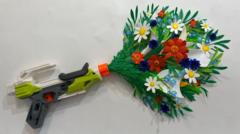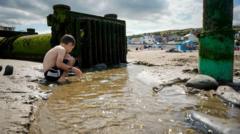Can Trash Become Treasure? Discover Art Made from Plastic Bottles and Old Toys!

Transforming Plastic Waste into Art: The Vision of Anya Beaumont
The ever-increasing presence of plastic in our daily lives has led to a crisis that many individuals are striving to combat. Among them is Bath artist Anya Beaumont, who has taken a unique approach to address this issue through her artistic lens. Beaumont’s "Hopeful Monsters" exhibition showcases stunning sculptures and wearable art crafted from discarded plastic waste, ranging from cleaning bottles to unwanted toys. In this article, we will explore her inspiration, the impact of her work, and how art can drive change in our perception of plastic waste.
Inspiration Behind "Hopeful Monsters"
Beaumont’s journey into the world of art made from plastic waste began with a personal realization. While reflecting on the sheer volume of plastic cluttering her home, she felt a mix of horror and urgency. "When I realized how much plastic was in my house, I wanted to do something creative with it rather than just chucking it in the recycling bin," she shared. This sentiment resonates with many, as the overwhelming amount of plastic waste is a shared concern in today’s society.
Recognizing the Problem
Beaumont's initial inspiration stemmed from observing the plastic items brought home by her children from school, particularly the notorious party bags filled with cheap toys that quickly end up forgotten and broken. "The infamous party bag would have a toy they loved for five minutes, and before you knew it, it was broken or forgotten about," Beaumont explained. This realization helped her understand the larger issue at hand — our collective reliance on single-use plastics and the impact it has on the environment.
Turning Waste into Art
Instead of viewing plastic waste as a nuisance, Beaumont saw it as a vibrant source of creative potential. "Using colorful unwanted plastic means that I've got a really vibrant source material to work with," she noted. By collecting and sorting plastic waste into various colors, she transforms these materials into intricate artworks that convey powerful messages about consumption and waste.
The Crafting Process
The process of creating art from plastic waste is both rewarding and challenging. Beaumont meticulously collects discarded items, cleaning and sorting them before beginning her artistic process. The vibrant colors and textures of the plastics inspire her designs, allowing for a range of artistic expressions. "I don't need to paint it; I can just collect it, sort it into different colors, and there it is, ready for me to use," she explained.
Community Engagement and Reactions
Beaumont’s exhibition has garnered attention not just for its artistic value but also for its community impact. Many visitors express relief at finally having a place to take their unwanted plastics. "I think a lot of people identify with what I'm doing," Beaumont stated. This connection creates a sense of community around the exhibition, where visitors feel inspired to rethink their own habits regarding plastic consumption and disposal.
Creating a Dialogue
Art has the power to spark conversations, and Beaumont’s work encourages viewers to engage in discussions about sustainability and environmental responsibility. Her exhibition serves as a reminder of the importance of reducing plastic waste and seeking creative solutions to a pressing problem. By transforming these materials into captivating art pieces, she invites viewers to reflect on their own relationship with plastic.
The Art of Hope
Beaumont’s "Hopeful Monsters" exhibition does more than showcase art; it embodies a message of hope and change. Each piece represents not just a physical transformation of materials but also a shift in mindset. By embracing the beauty in waste, she inspires others to see potential in what is often discarded.
Art as a Catalyst for Change
Through her work, Beaumont demonstrates that art can be a powerful vehicle for social change. By highlighting the issues surrounding plastic waste, she encourages her audience to consider their consumption habits and take action. "It’s quite depressing the amount of waste plastic," Beaumont admitted, but her work conveys a sense of optimism. "We can change our relationship with these materials." This transformation begins with awareness and education, both of which are central themes in her exhibition.
Wearable Art: Bringing the Message Home
In addition to her larger sculptures, Beaumont also creates brightly colored brooches that visitors can take home. These wearable pieces serve as a reminder of the exhibition's message and encourage ongoing conversations about sustainability. "By wearing these pieces, people can carry the message with them," Beaumont said, emphasizing the importance of personal responsibility in addressing plastic waste.
The Future of Plastic Waste Art
As artists like Anya Beaumont continue to explore the intersection of art and sustainability, the future of plastic waste art looks promising. With a growing awareness of environmental issues, more creators are likely to embrace this medium, pushing the boundaries of traditional art forms.
Encouraging Innovation
The potential for innovation within this genre is vast. Artists can experiment with different techniques, materials, and styles to produce works that not only capture attention but also provoke thought. By encouraging creativity in the face of environmental challenges, artists can help inspire new solutions and drive societal change.
Conclusion: A Call to Action
Anya Beaumont’s "Hopeful Monsters" exhibition is a testament to the transformative power of art in raising awareness about plastic waste. By turning discarded items into creative expressions, she invites us to reconsider our relationship with plastic and recognize the potential for change. Beaumont’s work highlights the importance of finding beauty and purpose in what is often overlooked, urging us to take responsibility for the materials we consume.
As we continue to navigate the challenges posed by plastic waste, let us remember that every small action counts. Whether it’s reducing our consumption, recycling responsibly, or supporting artists who tackle these issues, we all have a role to play. Beaumont's art encourages us to look at the world through a different lens, inspiring hope and action in the face of an environmental crisis.
FAQs
What inspired Anya Beaumont to create art from plastic waste?
Anya Beaumont was inspired by the overwhelming amount of plastic waste in her home and the realization of how much was being discarded, particularly through her children’s toys and party bags.
What types of materials does Beaumont use in her artwork?
Beaumont primarily uses discarded plastic items, such as cleaning bottles and broken toys, which she collects and transforms into sculptures and wearable art.
What is the main message behind Beaumont’s "Hopeful Monsters" exhibition?
The main message is to raise awareness about plastic waste and encourage people to rethink their consumption habits while finding beauty in what is often considered trash.
As you reflect on the message conveyed through Beaumont's art, how can you incorporate sustainable practices into your own life to reduce plastic waste? #PlasticWasteArt #SustainableLiving #HopefulMonsters
Published: 2025-07-18 15:30:16 | Category: technology



